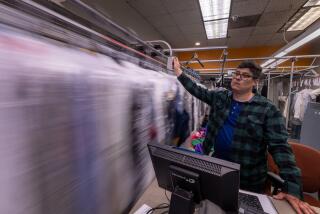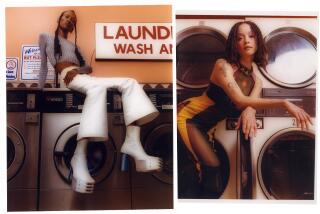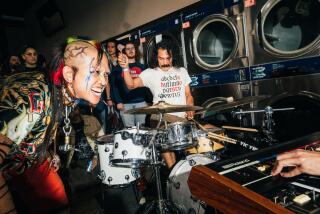A New Spin on Laundries : Want to exercise? See a movie? Get a tan? Sip mineral water? You no longer have to just sit and watch the clothes go ‘round.
- Share via
At a huge coin laundry on Van Nuys Boulevard in Pacoima, the owner recently built an area where kids can play and watch television while their parents do the wash.
In San Jose, a coin-operated laundry company called Oasis opened a facility last year in which customers could sip $1-a-bottle mineral water and snack on pizza or burritos while watching the latest movies on a big-screen television set.
And 18 months ago, a businesswoman and her son opened Clean & Lean--a laundry in Vista, just north of San Diego, where customers can also exercise, get a massage or work on their tan.
Ideas like these are suddenly sweeping the coin-operated laundry business--an industry once so sleepy, it attracted mostly absentee owners who visited their laundries only to collect money from the coin boxes.
Los Angeles County, with about 1,080 coin-operated laundries, is perhaps the nation’s most competitive market for these laundries, according to PWS Inc., a privately held company in City of Commerce that is one of the nation’s largest builders of coin laundries.
And the concentration of coin-operated laundries has been a big boon to consumers by keeping the cost of washing and drying clothes here much lower than the rest of the nation, experts say. But owners are having to pay closer attention to their facilities and dream up new ideas and promotions to attract customers and generate more revenue.
“California is the leading market for coin laundries and the trend is toward greater and greater amenities,” said Mark H. Miller, vice president of sales for PWS Inc., “Let’s face it, doing laundry is not exciting. You have one hour or 45 minutes to sit around” while your clothes are washing and drying.
The changes are taking place at a time when sales prices for California’s 3,600 coin operated laundries are climbing, competition from apartment laundry rooms is increasing and the market of traditional users of coin-operated laundries--young renters--is shrinking.
Topped the List
Until recently, owners of coin-operated laundries played a minimal role in the management of their facilities and depended on location and price to draw customers. But as higher energy prices raised costs and baby boomers--once young apartment renters--moved into homes with washing machines, owners began taking a more active role in management. Many are adding more amenities to their facilities to siphon off customers from the competition.
A new $300,000 coin-operated laundry in Fall River, Mass., for example, is decorated with hanging plants, a 27-inch television set, ceramic tile flooring and almond colored washers. It was judged the nation’s most beautiful coin laundry in a contest sponsored by American Coin-Op, a trade magazine based in Chicago.
Meanwhile, both Oasis and Clean & Lean are planning to build more laundries based on their upscale orientation and fitness themes.
“Our concept is to basically change the negative image of the typical Laundromat,” said Cor. S. Bregman, president and CEO of Oasis Laundries Inc. of San Jose. “We want to bring Laundromats into the 20th Century. After a year, most facilities look as if they were 10 years old. We have taken pains to offer extra (amenities) and to see that our facilities are nicer.”
Bregman said the company’s seven Northern California facilities had revenue totaling $1.5 million in their first year of business. At an average $215,000 per outlet, that is more than twice the $85,000 in annual revenue that the Coin Laundry Assn. says the average laundry earns.
Greg L. Trabert, president of Lean & Clean, estimated that his 25-washer laundry facilities in Azusa and Vista, each had gross revenue of more than $100,000.
“I think laundries that offer those kinds of services can survive if they are in areas where the (household) income is higher,” said Ben Russell, editor of Coin-Op, a Chicago-based trade magazine. “There’s a market for yuppies that live in rather nice neighborhoods but don’t want to buy washers and dryers.”
Yet while the addition of upscale amenities may be drawing yuppies and giving laundry facilities an improved image, experts say the real revolution could arrive in the coming months as a new generation of computer-controlled, digital washers and dryers are introduced to give laundry operators more flexibility over pricing and greater ability to detect counterfeit money and monitor energy consumption.
“It’s a flexibility we don’t have now,” said Stanley G. Scott, vice president of Kwik Wash Laundries Inc. in Dallas, the nation’s largest coin laundry operator. “I think they have a winner in those digital machines.”
Importance of Pricing
Jeff J. Isgrig, commercial regional sales manager for Maytag Co., which is marketing a new line of computer controlled washers, said the machines have electronic coin acceptors that can more easily detect slugs and counterfeit coins. And unlike most current machines, Isgrig said, the computerized washers can be programmed to change prices automatically according to the day of the week or time of day.
For example, he said, a Laundromat could charge lower promotion prices during slow mid-week or early morning hours to attract more business and higher prices during peak days and hours.
Many experts say such pricing features will have a greater impact on the coin laundry industry in the long run than the current trend toward extra amenities. Indeed, many doubt whether people who can’t afford a home washer and dryer will pay a premium for plush interior decorating or for movies, snack bars and gym equipment.
Duds & Suds, an Iowa-based chain that tried to combine washing machines and beer bars, for example, went out of business last year. And Scott of Kwik Wash Laundries in Dallas, notes that in most urban areas coin laundries are already located in busy commercial centers with nearby stores, fast-food restaurants and other diversions.
“In my area of the country (operators) with those kinds of amenities have not done very well,” Scott said, noting that the market for upscale laundries may be limited because the industry’s bread-and-butter client is typically a moderate or low income renter without a whole lot of money to spend on frills.
A recent survey by coin laundry owners in Wisconsin found that 65% of patrons in Wisconsin earn $12,000 a year or less. And the average nationwide price for washing a load of clothes actually declined from 88 cents in 1986 to 75 cents in 1987 amid cutthroat competition, according Coin Launderer & Cleaner, a Northbrook, Ill.-based trade publication. The average price rebounded to 99 cents in 1988.
Few Options
Oasis charges $1 to wash clothes in its plush facilities. And although Clean & Lean charges just 75 cents a load, customers must pay an extra $3.50 to use the exercise equipment, said Trabert, company president.
Coin-operated laundry owners note that they have little place else to turn to increase revenue besides adding frills and special promotions. There is no payroll to cut, because most Laundromats have little or no staff; major improvements have already been made to the energy efficiency of laundry equipment--with some owners installing solar panels and heat pumps to better generate heat, air-conditioning and electricity; and stiff competition has kept down price increases.
“Actually, the laundry business is not as good today as it was 15 years ago when energy prices were low,” said Russell of American Coin-Op magazine. He said owners are now trying to both lure more upscale customers and siphon away existing customers from the competition.
Despite the industry’s overall sluggish performance, asking prices for these laundries have been climbing at a steady clip, brokers say. Prices for laundries in California have doubled over the last three years and now sell for between $50,000 and $500,000 or 20 times monthly gross revenues, according to Jerry D. Hood, president of California Coin Laundries, a coin-laundry broker in Los Angeles. Profit margins range from 15% to 25%. But unlike a lot of other small businesses, he said, it doesn’t take a lot of sweat to earn that kind of profit.
“The coin laundry business is basically an absentee owner business,” said Hood, who has been in the business 13 years. “A guy who buys a liquor store has to plan on spending nine or 10 hours a day in the store; same thing with a dry cleaner. With a laundry, you just come by and pick up the money.”
But with the addition of amenities such as snack bars and exercise equipment as well as stiffer competition, some owners also are having to pay a great deal more attention to their facilities.
An All-Day Job
Los Angeles laundry owner Woodie M. Chung wears a beeper to keep up with the hectic pace at his 14 laundry facilities in the Los Angeles area. He makes the rounds of his facilities almost daily. He resets some machines at least twice weekly so that he can discount, to 50 cents a load, the normal wash price of 75 cents to lure in more customers. He also sometimes offers free soap on Wednesdays and Thursdays to attract customers during slow mid-week days and has to make sure the childrens’ play area at his Pacoima facility remains clean.
“It is an all-day job, sometimes seven days a week,” Chung said.
Besides the demand on their time, these owners are facing increased competition from apartment owners seeking greater profits from their laundry rooms.
Some owners of older apartment buildings are upgrading their equipment in an effort to keep a greater share of the laundry business for themselves, while many new large apartments are being designed with more attention to increasing laundry room revenues, experts say.
The laundry rooms are actually managed and maintained by so-called independent “route” operators affiliated with commercial appliance manufacturers. They maintain crews that install and maintain washers and dryers in apartment laundry rooms and give landlords a percentage of the laundry revenue. And business is apparently booming.
“Apartment owners are making better use of the laundry room, which they used to look at mostly as an afterthought,” said Isgrig of Maytag. “Our business used to be 60% to 40% in favor of the (independent) Laundromat; now it’s more like 50-50.”
More to Read
Inside the business of entertainment
The Wide Shot brings you news, analysis and insights on everything from streaming wars to production — and what it all means for the future.
You may occasionally receive promotional content from the Los Angeles Times.










